Math Intervention is a class or a period of time devoted to helping students who have been unsuccessful (typically on standardized tests) by providing additional time and resources. Oftentimes, a math intervention class is smaller in size or might include a co-teacher. In my experience, there is not a lot of structure, direction, or resources to support math intervention. Today, I am sharing my favorite math intervention schedule.
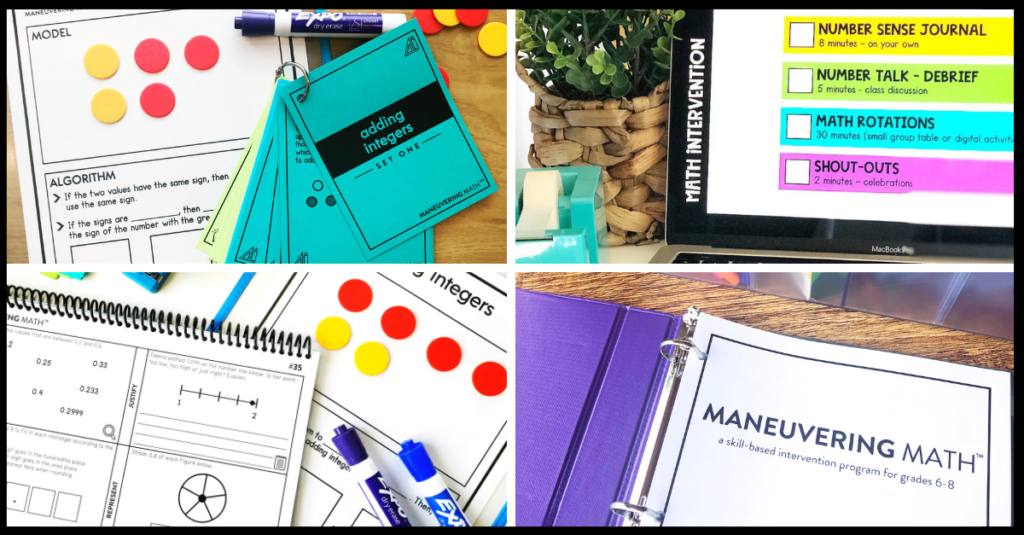
My Math Intervention Schedule
In my second year of math intervention, students were assigned to a math block class for 100 minutes. It was my role to teach the on-level content, as well as to set aside time for intervention. My co-teacher would join me for the second 50 minutes. This allowed for me to take a bit of extra time with the on-level lesson before switching gears for the intervention portion of the class. It was challenging because all of the students in the class struggled with math and had high needs.
After that year, my principal met with us, and we brainstormed other options. This quickly became my favorite math intervention schedule. Students attended an on-level math class and then would return to their math teacher at the end of the day for intervention class. In my case, we met during 8th period. Here is why I enjoyed this:
- Math intervention students were spread across on-level classes throughout the day.
- All of my students had already attended my on-level math class. This could also work if you met in the morning and had on-level classes in the afternoon.
- My co-teacher came during math intervention time to allow for more small group instruction.
- Two 50 minute blocks are more impactful that one 100 minute block, in my opinion.
IDEAS FOR Daily Activities
In order to build fluency with math skills, there were quite a few things that were a part of our daily rhythm. I have also done quite a bit of research since my original post and have included several suggestions below:
Math skills
We would do timed math skills to build fluency. I started the year with a 12-by-12 multiplication table that had empty squares. Each day, the missing squares changed. The goal was to build confidence, as well as mathematical fluency. As time went on, I moved to fraction, decimal, and percent conversions, and other fluency-related concepts.
Research shows that requiring students to do things that are timed doesn’t necessarily improve their fluency and can cause anxiety. This is something I wasn’t aware of at the time, and I wanted to be upfront as to the fact that I wouldn’t recommend it now.
What would I recommend now instead…
Number Sense Building
We still want students to build their number sense and numerical fluency, plus we want them to gain confidence at the same time. This can be accomplished with the same topics as above but can be more discussion- and strategy-based so that students are focused on the thinking and not just on the correct answers. I share more ideas on number sense building here.
Quick Debrief of On-Level Class
I would check in with my intervention kiddos to see how they felt about the lesson and what questions they still had. This was informal, but it was useful when we had a difficult lesson. It also helped to create a safe place, because some students might not feel comfortable asking in a larger class.
Homework
Depending on the assignment from the on-level class, I liked to provide about 10 minutes for students to work on homework. This did not always happen, but 10 minutes is the goal.
Weekly MATH INTERVENTION Activities
Center Rotations
We typically had four center options in my class: small group with me, computers, and two activity stations. The activities varied, but my requirements were that they had to be fairly self-sufficient, and I had an incentive tied to a recording sheet.
Small Group Instruction
I think small group instruction can be incredibly impactful in this type of setting. Often, students in math intervention lack motivation and grit. Small group was my opportunity to correct misconceptions, to encourage successes, and mostly to question them through the process. You can find how I was able to track data here.
Pre-Teaching or Review
About once a week, we would focus on a new concept that was coming up in our on-level curriculum. This allowed me to break it down in bite-sized pieces and helped students to see it prior to their on-level class.
MATH INTERVENTION Weekly Schedule
Friday: Review and Weekly Conversations
UTILIZING Co-TeacherS
Another reason this schedule was incredible was the fact that my co-teacher came during intervention time. It was difficult to give her up during my larger on-level classes, but I think she was better utilized during intervention time. Oftentimes, she would circulate the room to help students while I pulled small groups. Other times, she would pull small groups. It was nice to have her in a class that was so hands on!
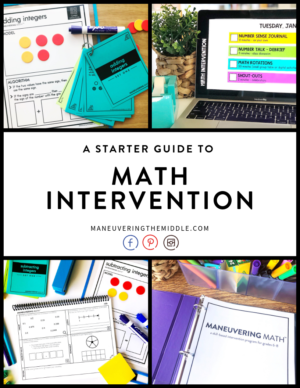
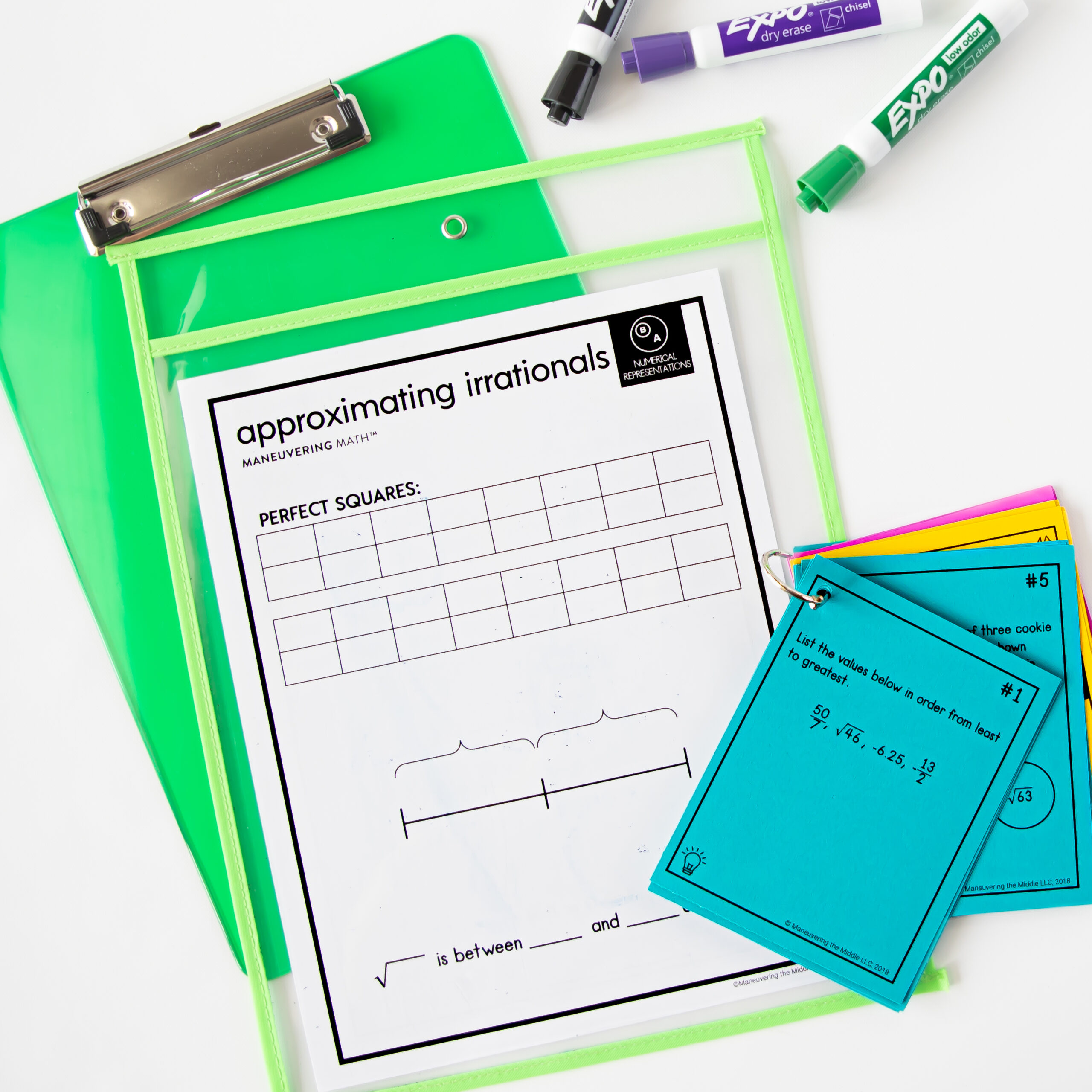
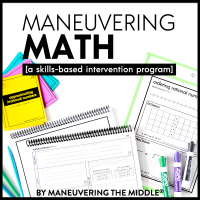

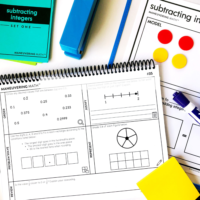
This is a wonderful place to share intervention ideas! Thank you for putting this out there! I’m in the final trimester of my first year as the math interventionist at a middle school, and I feel like so much of my time has been trial and error. Glad I found this to help add to my ideas for structuring the program going forward.
Thanks Katie! I appreciate the kind words. Yes, please share any ideas you have found success with. Intervention is so tricky!
Noelle, I needed this advice last year in 6th grade! I attempted to do something very similar to your schedule but, I had a large amount of behavior problems and my class was a dumping ground for students who couldn’t cut in enrichment. This year I am teaching 4th grade with better results. My plan is to adapt your math intervention schedule for my 4th graders. Thank you for sharing your ideas and resources 🙂
Thanks so much, Nichelle! Intervention classes are so tough and you are right, lots of kiddos just get placed in there because it is easier. I am glad you are having more success this year! I will do my best to get some other great ideas out in the near future.
I’m very interested in this resource, however I put in my personal email and my work email and never received the link to download. Am I too late or did I do something wrong?
Thanks for your time!
Heather, I am so sorry! I am not sure what happened. Maybe junk mail? It will have a subject line “Important: A Starter Guide to Math Intervention”. I am going to try again on my end, let me know if you get it or use the contact me feature and I will reply with the attachment. Thanks for your patience!
I tried to get the starter guide for math intervention and for some reason it never worked. Could you please send it to me? I teach 5th grade math and this looks like something I would really be interested in! Thanks so much! Lee Ann Klaiber
Hi Lee Ann, I am sorry about that! I have manually sent it over, so please use the contact me feature on my site if you don’t end up getting it. Thanks!
When you used multiplication tables with different missing values each day (for skill drills), did you make those by hand each day or do you have another trick or resource to make these?
Hi Jennifer! I made the 12 x 12 on my computer and then would just delete various answers and print. Thanks!
A huge thank you. I am starting centers in a middle school resource room and am looking for anything to help plan. I plan to do mostly remediation in both math and reading with the students.
THANK YOU for the great and free resource.
Glad you like it Emilie! Thank you!
I’m very interested in the starter guide. I typed in my email address and did not receive the guide. I checked my junk folder, but could not find it. Would you be able to send it to me? Thank you so much!
Hi Laura, I am so sorry! Sometimes school email accounts do like my email provider. Email me or use the contact us page and I will get it right over. Thanks!
Hi Noelle,
I am excited to find this resource. I tried a couple times to have it sent to me, but I haven’t received it. Would you send it to me? Thank you!
Hi Renee! So sorry about that! Sometimes school email addresses don’t like my email provider. I would suggest trying another email address. Thanks!
Hello!
I am a Math Interventionist- so this site is very helpful to me, as I have always struggled with the best structure for the class that will reach all students. You mentioned for your rotations that you had a recording sheet with incentives. Do you have a copy of what that looks like??
Thank you!
Hi Ashley! Thanks for your kind words. It was super basic- just a one page with the various rotations I expected them to complete and then anything I wanted them to record. For some students, I would initial their work when I checked it. But overall, it just provided a bit of accountability, a place to show work, and I was able to keep track of who had earned what incentive.
I am so excited, I just found your site. I am a Math Intervention Specialist who works with 5th through 8th grade students. I have been using a center based approach for the last 5 years and am constantly looking for ways to improve my centers. I look forward to following your site and visiting your store (wish I could buy all of it!)
Thanks so much, Angela!
Thanks for your helpful ideas and insights. I am a math interventionist for mixed 7-8 classes in a junior high. A challenge I am facing so that my class only meets every-other day on a Day 1/Day 2 Schedule. Some weeks I see students on M-W-F and then T-Th the following week for a 60 minutes period. What adaptations might you offer a for schedule like mine?
That is a great question Amanda! I think that I would for sure incorporate a time of pre-teaching. Since you won’t be able to address misconceptions right away, I think that it could be beneficial to preview some of the concepts and give students a confidence boost when they see the content in their online class. Hope that helps!
We have a 25 minute RTI class every day. My class has 20 kids that range from 1st to 70th percentile in math. We have been told to do centers but I’m struggling with student buy-in and meeting such a range of needs. Any suggestions?
Hi, Hannah! Wow, that is quite a range. I would suggest using Khan academy for some of your higher students. Here are some posts to help. Here and here. And working with some of the lower percentile students on foundational skills in a small group. Here are some tips to get you started. Best of luck!
Thank you.
hi Noelle. This is my first time teaching Math intervention. I started last week and the school does not have any curriculum to work with. My mind is all over the places since I have 6th-8th grade Tier 2 and 3. We meet every other day.The tier 2 classes are 45 minutes and tier 3 90 minutes. I also don’t have a classroom since I am in a cart. How can you help me with structure, content and centers? I need ideas.
Hi, Kayra! Wow, that sounds like quite a challenge, but something you can totally conquer! I have not used a cart to teach before, but I am going to pose this question to our Facebook group and see if any teachers can help you out.
Check out this link to read more about anything we have written on intervention.